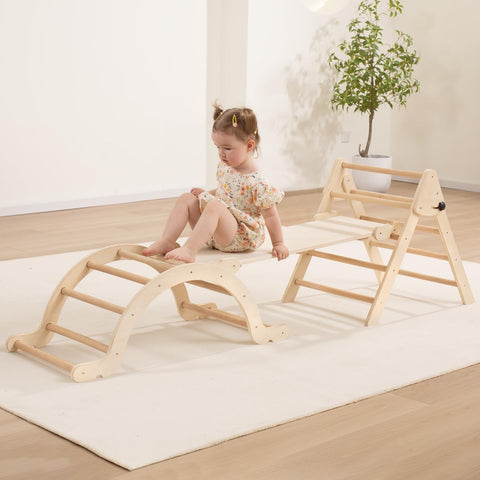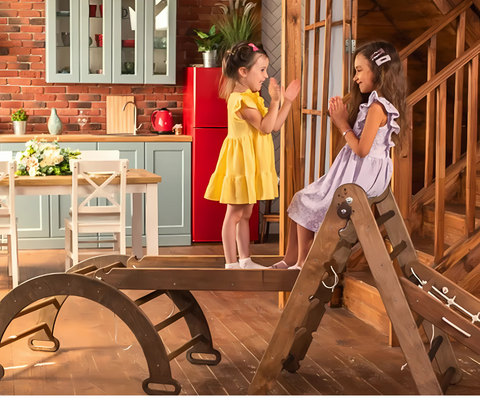Introduction to indoor climbing frames
What are indoor climbing frames?
Indoor climbing frames are special play equipment designed for indoor use. They usually consist of climbing walls, slides, swings and other adventurous elements that offer children a variety of play options. These climbing frames are designed to be set up in living spaces to provide children with a safe and exciting environment to play in.
The advantages of indoor climbing frames for children aged 3 and over
Indoor climbing frames offer numerous benefits for children aged 3 and over. They not only encourage physical activity, but also the development of motor skills and balance. The colorful and child-friendly designs appeal to children's senses and stimulate their imagination. In addition, these climbing frames offer a safe play environment in which the little ones can test their limits and develop their skills.
Why indoor climbing frames are becoming increasingly popular
Indoor climbing frames have grown in popularity in recent years. This is mainly because they offer an ideal solution for rainy days or the cold winter months when outdoor play is restricted. They also allow parents to let their children play in a safe environment without having to leave the house. The variety of designs and sizes makes it easy to find a suitable climbing frame for every home.
Types of indoor climbing frames

Small climbing frames
Small climbing frames are ideal for homes with limited space. They often include basic elements such as climbing walls and small slides and are perfect for younger children who are just beginning to develop their motor skills.
Medium-sized climbing frames
These climbing frames offer a wider variety of play options. They may include swings, nets or tunnels in addition to the basic features. Medium-sized climbing frames are a good choice for families who have a little more space and want to offer their children a more extensive play experience.
Large climbing frames
Large indoor climbing frames are true adventure landscapes. They often include complex structures with multiple levels, swings, slides and climbing nets. These climbing frames are ideal for larger spaces and for children who like to play and move around intensively.
The best materials for indoor climbing frames
Wood
Wood is a popular material for indoor climbing frames because it is robust and durable. It gives the climbing frame a natural look and fits well into many interior design styles. Wooden frames are often a little more expensive, but offer high quality and stability.
metal
Metal climbing frames are also very stable and durable. They are usually lighter and easier to assemble than wooden frames. Thanks to different coatings, they can be available in many colors and are therefore also visually appealing.
plastic
Plastic climbing frames are lightweight and often cheaper than wooden or metal structures. They are available in many bright colors and shapes and provide a safe and child-friendly play environment. Plastic is also easy to clean and weatherproof, which makes cleaning and maintenance easier.
Safety aspects of indoor climbing frames
Safety standards and certifications
When purchasing an indoor climbing frame, parents should pay attention to safety standards and certifications. Products that have been tested and certified by recognized organizations offer an additional level of safety. It is important that the climbing frame is stable and does not have any sharp edges or small parts that could be swallowed.
Care and maintenance
Regular care and maintenance of an indoor climbing frame is crucial for safety. This includes checking connections and screws, cleaning surfaces and replacing worn or damaged parts. A well-maintained climbing frame will remain safe and functional for longer.
Promoting motor skills and balance
How indoor climbing frames promote motor skills
Indoor climbing frames are excellent tools for promoting children's motor skills. Climbing, swinging and sliding strengthen muscles and coordination. Children learn to control their movements and develop a better sense of their bodies.
Balance and coordination
Another important aspect of indoor climbing frames is the promotion of balance and coordination. The different climbing elements require different movements and postures that challenge balance. Children learn to move safely and adjust their body positions, which also benefits them in everyday life.
Design of an indoor climbing frame
Colors and designs
The design of an indoor climbing frame plays an important role in its attractiveness and fun factor. Bright colors and child-friendly designs appeal to children's senses and make playing even more exciting. There are countless ways to adapt the climbing frame to the children's preferences.
Adaptation options to the room
Indoor climbing frames are available in different sizes and shapes so that they can be adapted to the space available in every home. From modular systems that can be expanded to compact units for small spaces, there is a suitable solution for every living situation.
Installation and assembly
Step-by-step instructions for assembly
Building an indoor climbing frame can be a challenge, but with detailed instructions it is doable. First, the installation site should be prepared and all parts checked. Step by step, the individual elements are screwed together and stabilized until the climbing frame is secure.
Common mistakes and how to avoid them
A common mistake during assembly is missing important connection points or tightening screws incorrectly. To avoid this, the instructions should be followed carefully and all parts should be checked before final assembly. It can also be helpful to have a second person help assemble the climbing frame to ensure stability and safety.
Additional gaming options
Slide
Slides are a popular additional feature for indoor climbing frames. They are not only fun, but also promote balance and coordination. They are available in different lengths and shapes to suit different climbing frame sizes.
Rock
Swings are a great addition to any climbing frame. They offer children the opportunity to relax while exercising their motor skills. There are different types of swings, from simple seat swings to nest swings that can be used by several children at the same time.
Climbing nets
Climbing nets significantly expand the play options of a climbing frame. They encourage climbing and balancing and can be integrated horizontally or vertically. Climbing nets are particularly suitable for strengthening children's arm and leg muscles.
Indoor climbing frames for different age groups
For children aged 3 and over
For children aged 3 and over, smaller and simpler climbing frames are ideal. These models are specifically designed to meet the needs and abilities of younger children and offer basic climbing and play opportunities.
For older children
Older children need more challenging climbing frames with more varied play options. Larger structures with more complex climbing elements, swings and nets are ideal for encouraging the urge for movement and creativity of older children.
Care and maintenance of indoor climbing frames
Regular inspection
Regular inspection of the climbing frame is important to ensure that all parts are in good condition. There should be no loose or damaged parts that could endanger the safety of children.
Cleaning and care
Cleaning an indoor climbing frame is simple but necessary to keep it hygienic and attractive. Wooden and plastic parts can be wiped down with a damp cloth, while metal parts may need to be repainted occasionally to prevent rusting.
Creative ideas for indoor climbing adventures
Theme worlds
Indoor climbing frames can be integrated into themed worlds to make the play experience even more exciting. Themes such as jungle, space or pirate adventures stimulate children's imagination and offer additional play options.
Integration of educational toys
Integrating educational toys into the climbing frame can further promote children's development. These can be puzzles, flashcards or interactive games that train children's cognitive skills.
Buying advice for parents
What to look for when buying
When purchasing an indoor climbing frame, parents should pay attention to several factors, including the size, material, safety standards and the ability to adapt to their own space. It is important that the climbing frame is stable and safe and meets the needs of the children.
Recommendations and test reports
It is helpful to read recommendations and test reports before buying. Parents can benefit from the experiences of others and choose the best models for their children. Test reports often provide valuable information about the quality and safety of the various climbing frames.
Popular brands and manufacturers
Overview of the top brands
There are numerous brands and manufacturers that offer high-quality indoor climbing frames. The best known include Wickey, FATMOOSE and IndoorGym. These brands are known for their quality and safety and offer a wide range of climbing frames.
What distinguishes the individual brands
Each brand has its own special features. Wickey is known for its robust wooden frames, while FATMOOSE offers colorful and creative designs. IndoorGym specializes in space-saving solutions that can also fit in smaller apartments.
Costs and budget planning
Price ranges
The cost of indoor climbing frames can vary greatly depending on the size, material and features. Smaller models are available from around 100 euros, while larger and more complex climbing frames can cost several hundred euros.
Financing options
There are various financing options for families who want to buy a high-quality climbing frame. Some manufacturers offer installment payments, and there are also special grants or subsidies for family-friendly purchases.
Testimonials from parents
Positive experiences
Many parents report positive experiences with indoor climbing frames. They appreciate the opportunity to offer their children a safe and fun play environment even in bad weather. Most children love the variety of play options and the challenge of testing their skills.
Challenges and solutions
Some parents also report challenges such as setting up or placing the climbing frame. However, with careful planning and perhaps the help of professionals, these challenges can usually be easily overcome.
FAQ about indoor climbing frames
General Questions What are indoor climbing frames and why are they good for children?
Indoor climbing frames are indoor play equipment that allows for climbing, swinging and sliding. They promote children's motor skills, balance and physical activity while having fun.
Which age group is suitable for indoor climbing frames?
Indoor climbing frames are available in different sizes and levels of difficulty and can be used by children from 3 years old up to older children.
How safe are indoor climbing frames?
Indoor climbing frames are generally safe if they meet current safety standards and are regularly maintained. Parents should ensure that all parts are stable and well secured.
Installation How difficult is it to assemble an indoor climbing frame?
The assembly of an indoor climbing frame can be more or less demanding depending on the model. However, with good instructions and perhaps the help of a second person, the assembly is usually manageable.
What should you pay attention to during installation?
It is important to choose a stable and safe location. All parts should be firmly connected and regularly checked for stability.
Safety What safety standards should indoor climbing frames meet?
Indoor climbing frames should comply with and be certified to the European safety standards EN 71. These standards ensure that the climbing frame is safe and suitable for children.
Care and Maintenance How often should you inspect an indoor climbing frame?
An indoor climbing frame should be checked regularly, at least once a month, for safety. Loose screws or damaged parts should be repaired or replaced immediately.
How do you properly care for an indoor climbing frame?
The care of an indoor climbing frame depends on the material. Wood should be treated and cared for regularly, while metal and plastic can simply be cleaned with a damp cloth.
Conclusion and summary
In summary, indoor climbing frames are a fantastic way to provide hours of fun and entertainment for children aged 3 and up. They encourage children's motor skills, balance and physical activity in a safe and exciting environment. With the right selection, installation and care, parents can create a playful world of adventure for their children that can be used all year round. Start your children's climbing adventure today and experience the many benefits of an indoor climbing frame!



